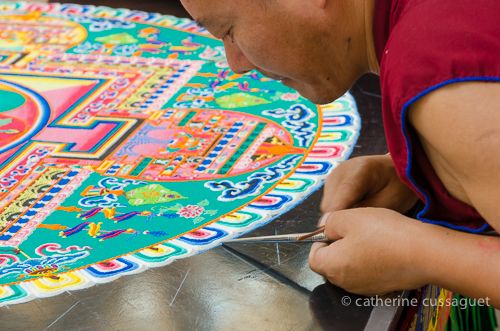
Tibetan monks drawing a sand mandala
Recently in Aspen, a group of Tibetan monks from Drepung Loseling Monastery, www.drepung.org/, built a beautiful sand mandala at the Aspen Art Museum. I watched them work tirelessly as the mandala was taking shape, wondering how their slow practice could inspire us who live in our fast world.
Mandalas exist in a lot of ancient traditions and Tibetan mandalas have their roots in the Tantric legacy of Buddhist India, back 2,500 years ago. Mandalas have a round shape and represent the cosmos. The colorful geometric patterns are not just a visual beauty but also a spiritual practice. For the Tibetans, building a mandala and then dismantling it after completion has a healing power. Some sand is given to the attendants for their own healing and the rest is poured into a river to reach the oceans and all parts of Earth. This wonderful gesture has always captivated me as well as the beauty of all the mandalas I have seen through my travels to the Himalayas. But I also find this practice to be a lesson in selfless service; their art is not signed and the ephemeral quality of the work is an invitation for us to reconnect to the idea of the present moment being the most important.
For any observer, the concentration and precision of the monks’ work is striking. These days, we so often find ourselves distracted or multitasking. It is easy to believe that multitasking will allow us to get more done. Not only is it not true, as our attention just switches from one activity to the other one, but it is also tiring for our brain, contributing to fatigue and early aging. Several studies are showing this, like this one from Stanford University: http://news.stanford.edu/2009/08/24/multitask-research-study-082409/ This multitasking is quite a contrast with the concentration and patience that I could observe in the monks while they were building the mandala. They stood around the table, gently tapping on their tool to drop sand with the highest precision, so the complex figure would be completed in four days. No music was played. It is true that classical music helps concentration, but in today’s world, the constant background of any kind of music everywhere we go is more distracting and tiring than supporting our concentration. Except for some guidance given by the leading monk at times, barely a few words were exchanged. We could hear the whispering of people around us, but naturally we also lowered our voices and slowed down our movements, somewhat in tune with the monks’ work. Obviously, it was a sign of respect, and for me, it also showed how our actions and behaviors influence the people around us. It is a good example of how changing ourselves contributes to changing the world.
Even if we are not working on a mandala, developing this quality of concentration is essential both for our capacity to achieve our goals in everything we do and for our brain health. Unfortunately, focus is not always something that we have learned in school. Or, if we have learned it, the opportunities of being distracted in our modern society seem to be growing more and more, especially with the overuse of electronics. So should we start building mandalas? Why not! The capacity for our mind to concentrate can be easily developed by the daily practice of meditation. It is one of the many benefits. Meditation supports our health by lowering the inflammation response, helping us respond to stressful situations and teaching us openness and curiosity. Research shows how a few weeks of 20 minutes of daily meditation brings changes in the brain. http://www.collective-evolution.com/2014/12/11/harvard-study-unveils-what-meditation-literally-does-to-the-brain/
I came to meditation in search of a sense of calm and more clarity in my life. Then I became an instructor in Primordial Sound Meditation, trained at the Chopra Center, http://www.chopra.com It has allowed me to deepen my practice, teach it to many people around me, and, as a result, has influenced all aspects of my life.
I believe a daily practice of meditation can be our mandala making and a great way to improve our well-being and that of others. But, if you have the chance to come across some monks building a mandala, do not pass on observing them at work for the beauty of their practice and the great energy that they carry around them.

